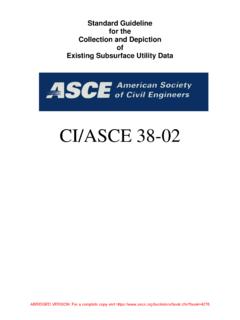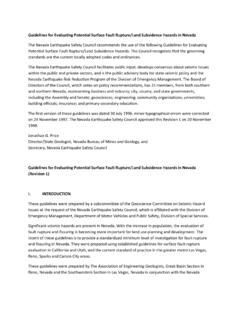Transcription of Chapter 8. Mine Ventilation Thermodynamics
1 Chapter 8. Mine Ventilation Thermodynamics Malcolm J. McPherson 1 Chapter 8. Mine Ventilation Thermodynamics INTRODUCTION ..1 COMPONENTS OF THE MINE CYCLE ..2 Elements of the 2 The downcast 2 Example.. 8 Level workings .. 14 Upcast shaft.. 17 Example.. 17 THE COMPLETE MINE CYCLE ..21 Natural Ventilation .. 21 Combined fan and natural Ventilation .. 26 Case Study .. 30 General observations on the table of 32 Polytropic 32 Fan 33 Natural ventilating energy, 33 Natural ventilating pressure. 34 Heat Inclined workings .. 36 Dip 36 Rise Circuit.. 40 The effect of moisture .. 40 BIBLIOGRAPHY ..41 APPENDIX ..42 Survey data from the survey of the shafts used in the examples given in Sections and 42 APPENDIX.
2 44 A general steady flow analysis for airstreams that carry water vapour and liquid water 44 INTRODUCTION Many of the world's practising mine Ventilation engineers - perhaps, even, the majority perform their duties very successfully on the basis of relationships that assume incompressible flow. Some of those engineers may question the need to concern themselves with the more detailed concepts and analyses of Thermodynamics . There are, at least, two responses to that query. First, if the ranges of temperature and pressure caused by variations in elevation and heat transfer produce changes in air density that are in excess of 5 per cent, then analyses that ignore those changes will produce consistent errors that impact significantly on the accuracy of planned Ventilation systems.
3 In practical terms, this means that for underground facilities extending more than 500 m below the highest surface connection, methods of analysis that ignore the compressibility of air may be incapable of producing results that lie within observational tolerances of accuracy. However, there is a second and even more fundamental reason why all students of the subject, including practicing engineers, should have a knowledge of mine Ventilation Thermodynamics . Chapter 8. Mine Ventilation Thermodynamics Malcolm J. McPherson 2 Although the incompressible flow relationships are simple to apply, they are necessarily based on an approximation. Air is, indeed, highly compressible. It follows, therefore, that if we are truly to comprehend the characteristics of subsurface Ventilation systems, and if we are really to understand the behaviour of large-scale airflow systems then this can be accomplished only if we have a grasp of steady-flow Thermodynamics .
4 In this Chapter , thermodynamic analyses are carried out on a downcast shaft, underground airways and an upcast shaft. The three are then combined to produce a thermodynamic cycle for a complete mine, first, with natural Ventilation only, then for the more usual situation of a combination of fans and natural Ventilation . In all cases, the analyses utilize pressure-volume (PV) and temperature-entropy (Ts) diagrams. This Chapter assumes familiarity with the basic concepts and relationships that are developed in Chapter 3. It is suggested that the reader study that Chapter before proceeding with this one. One further point - the temperatures and, to a lesser extent, pressures of the air are affected by variations of water vapour in the air.
5 The final section of this Chapter outlines the modifications that can be made while a more detailed treatment of moisture in air is given in Chapter 14. However, for the time being, we shall assume that the airways are dry and not affected by evaporative or condensation processes. COMPONENTS OF THE MINE CYCLE Elements of the system. A subsurface Ventilation system follows a closed cycle of thermodynamic processes and can be illustrated by visual representations of those processes on thermodynamic diagrams that are analogous to the indicator diagrams of heat engines. It was this resemblance that led Baden Hinsley (1900-1988) into the realization that a mine Ventilation system is, indeed, a gigantic heat engine. Air enters the system and is compressed and heated by gravitational energy as it descends in downcasting shafts or slopes.
6 More heat is added to the air from the strata, machines and other sources. Work is done by the air as it expands during its ascent through upcast shafts or slopes. Some of the added heat is converted temporarily to mechanical energy and assists in promoting airflow. In the great majority of mines , this "natural ventilating energy" is supplemented by input fan work. When the exhaust air re-enters the pressure sink of the surface atmosphere, it cools to the original entry conditions, closing the cycle. Figure illustrates the descending flow through a downcast shaft between stations 1 and 2, level workings 2 to 3, and returning to surface through an upcast shaft 3 to 4. We shall analyze each of the three processes separately before adding the isobaric (constant pressure) cooling in the surface atmosphere to complete the cycle.
7 The downcast shaft Air enters a downcast shaft at the pressure and temperature of the atmosphere existing at the top of the shaft. As the air falls down the shaft, its pressure increases, just as the pressure on a diver increases as he descends into the ocean. The rise in pressure is caused by the increasing weight of the overlying column of fluid as we plunge deeper into the fluid. However, that simple observation belies the common belief that air always flows from a high pressure region to a connected lower pressure region. In a downcast shaft, exactly the opposite occurs showing how easily we can be misled by simplistic conceptions. The process of gravitational compression, or autocompression, in the downcast shaft produces an increase in temperature of the air.
8 This is independent of any frictional effects and will be superimposed upon the influence of any heat transfer with the surrounding strata that may occur across the shaft walls. The rate of that heat transfer depends upon the thermal properties of the rock and the difference between the rock temperature and air temperature at any given horizon. Chapter 8. Mine Ventilation Thermodynamics Malcolm J. McPherson 3 Now, while the temperature of the mass of rock surrounding the shaft may change relatively slowly with time, the air temperature at the shaft entrance can change from hour to hour and, especially, between day and night. Because of these surface variations, it is common for the walls and rock surrounding a downcast shaft to absorb heat during the day and to emit heat during the night.
9 The phenomenon continues along the intake airways and tends to dampen out the effects of surface temperature variation as we follow the air into a subsurface facility. This is sometimes called the "thermal flywheel". For the purposes of this Chapter , we shall assume that any heat exchange that takes place in the downcast shaft is distributed equitably so that the process approximates closely to a polytropic law. If we descend a downcast shaft, stopping every hundred metres or so to take measurements of pressure and temperature, we can plot the PV and Ts diagrams using equation ( ): kgm3 PRTV= ( Chapter 14 shows how this relationship should be amended for the presence of water vapour). Equation ( ) allows us to determine the variation of entropy KkgJlnln)( = ababpabPPRTTCss The starting point for the latter equation may be any defined temperature and pressure datum.
10 It is differences in entropy rather than absolute values that are important. 1 2 34 Figure Elements of the systemChapter 8. Mine Ventilation Thermodynamics Malcolm J. McPherson 4 The diagrams that emerge have the appearance of those given in Figure In practice, there is often a scatter of points near the end extremities of the shaft due to high turbulence and uneven mixing of thermally stratified airstreams. The first step in the analysis of the data is to conduct a curve fitting analysis to the points on the PV diagram. The form of the equation to be fitted is the polytropic law nVCP= where C is a constant and n the polytropic index. Least squares regression analyses are widely available for personal computers and hand calculators.




